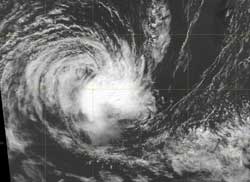NASA Sees Cyclone Irina Weaker in Mozambique Channel

The MODIS instrument on NASA's Aqua satellite captured this visible image of Cyclone Irina on March 9 at 1048 UTC (5:48 a.m. EST). The strongest part of the storm is south of the center, and wind shear is now taking a toll on the storm's strength. Credit: NRL/NASA <br>
On March 8 at 1500 UTC (10 a.m. EST), Irina's winds had finally dropped below 45 knots (51.7 mph/83.3 kph) to 35 knots (40.2 mph/64.8 kph) making it a minimal tropical storm. Irina was still in the southern Mozambique Channel, centered near 29.5 South and 37.8 East. That is about 350 miles southeast of Maputo, Mozambique. Irina is moving to the west at 8 knots (9.2 mph/14.8 kph).
The Moderate Resolution Imaging Spectroradiometer (MODIS) instrument on NASA's Aqua satellite captured this visible image of Cyclone Irina on March 9 at 1048 UTC (5:48 a.m. EST) that showed the bulk of clouds and showers south of the center of circulation, with some outer bands of thunderstorms to the west.
Infrared satellite imagery shows that the strongest thunderstorms, located in the southeastern quadrant have weakened and are being pushed away from the center from wind shear. Once a tropical cyclone is no longer “stacked” vertically on top of itself, it weakens, and that's what is happening to Irina.
In addition to increased wind shear, sea surface temperatures are below the 80 degree Fahrenheit threshold (26.6 C) needed to maintain a tropical cyclone, so the cooler waters are preventing evaporation and energy feeding into the storm.
The Joint Typhoon Warning Center expects that Irina will finally dissipate at sea over the weekend.
Text Credit: Rob Gutro
NASA Goddard Space Flight Center, Greenbelt, Md.
Media Contact
More Information:
http://www.nasa.govAll latest news from the category: Earth Sciences
Earth Sciences (also referred to as Geosciences), which deals with basic issues surrounding our planet, plays a vital role in the area of energy and raw materials supply.
Earth Sciences comprises subjects such as geology, geography, geological informatics, paleontology, mineralogy, petrography, crystallography, geophysics, geodesy, glaciology, cartography, photogrammetry, meteorology and seismology, early-warning systems, earthquake research and polar research.
Newest articles

Trotting robots reveal emergence of animal gait transitions
A four-legged robot trained with machine learning by EPFL researchers has learned to avoid falls by spontaneously switching between walking, trotting, and pronking – a milestone for roboticists as well…

Innovation promises to prevent power pole-top fires
Engineers in Australia have found a new way to make power-pole insulators resistant to fire and electrical sparking, promising to prevent dangerous pole-top fires and reduce blackouts. Pole-top fires pose…

Possible alternative to antibiotics produced by bacteria
Antibacterial substance from staphylococci discovered with new mechanism of action against natural competitors. Many bacteria produce substances to gain an advantage over competitors in their highly competitive natural environment. Researchers…





















